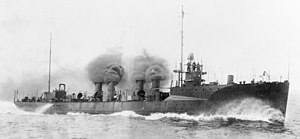Smith-class destroyer

USS Flusser
|
|
| Class overview | |
|---|---|
| Name: | Smith class |
| Operators: |
|
| Preceded by: | Truxtun class |
| Succeeded by: | Paulding class |
| Subclasses: | Flusser |
| Built: | 1908-1910 |
| In commission: | 1909-1919 |
| Completed: | 5 |
| Scrapped: | 5 |
| General characteristics | |
| Type: | Destroyer |
| Displacement: |
|
| Length: | 293 ft 10 in (89.56 m) |
| Beam: | 26 ft 0 in (7.92 m) |
| Draft: | 8 ft 0 in (2.44 m) |
| Installed power: |
|
| Propulsion: | 3 × shafts |
| Speed: | 28 knots (52 km/h; 32 mph) (design) |
| Range: | 2,800 nautical miles (5,200 km) at 10 knots (19 km/h; 12 mph) |
| Capacity: | 304 long tons (309 t) coal (fuel) |
| Complement: |
|
| Armament: |
|
The Smith-class destroyers were the first ocean-going destroyers in the United States Navy, and the first to be driven by steam turbines instead of the reciprocating engines fitted in the sixteen earlier and much smaller torpedo boat destroyers ordered in 1898. Flusser and Reid are sometimes considered to be Flusser-class ships. Also, since Flusser was completed first, some period documentation refers to the entire class as Flussers.
The first three of the class were ordered under the Act of 29 June 1906 "to have the highest practical speed, and to cost, exclusive of armament, not to exceed seven hundred and fifty thousand dollars each". The remaining pair were ordered under the Act of 7 March 1907 "to have the highest practical speed, and to cost, exclusive of armament, not to exceed eight hundred thousand dollars each".
All of the ships served as convoy escorts in World War I, and several attacked U-boats. The latter four vessels were all sold in November 1919 following the end of World War I; Smith survived another two years as a bombing target until scrapped.
These were the first turbine-powered destroyers in US service, and the last to be coal-fired. Surprisingly, turbines were dictated by cost; when bids were opened, all of the turbine-powered proposals were lower than all of the reciprocating proposals. The Smiths were greatly enlarged Truxtuns; at 900 tons full load they were 50% larger. The extra displacement went into increased armament and more powerful machinery to maintain the Truxtuns' 28-knot (52 km/h; 32 mph) speed. The raised forecastle improved seaworthiness. Also, the coal capacity was increased to 304 tons, nearly half the total full load displacement of the previous class. The increased size and range meant that these were the US Navy's first truly ocean-going destroyers, capable of operating with battleships on long voyages. The seizure of the Philippines in the Spanish–American War and the acquisition of Hawaii, both in 1898, had shown the need for long-range ships. Shortly before the Smith class entered service, the Great White Fleet of 1907–09 demonstrated that the US Navy was prepared to operate far from home. Ironically, these destroyers would quickly be nicknamed "flivvers" (after the small and shaky Model T Ford) for their small size when the subsequent "thousand tonners" (Cassin through Sampson classes) entered service in 1913.
...
Wikipedia
